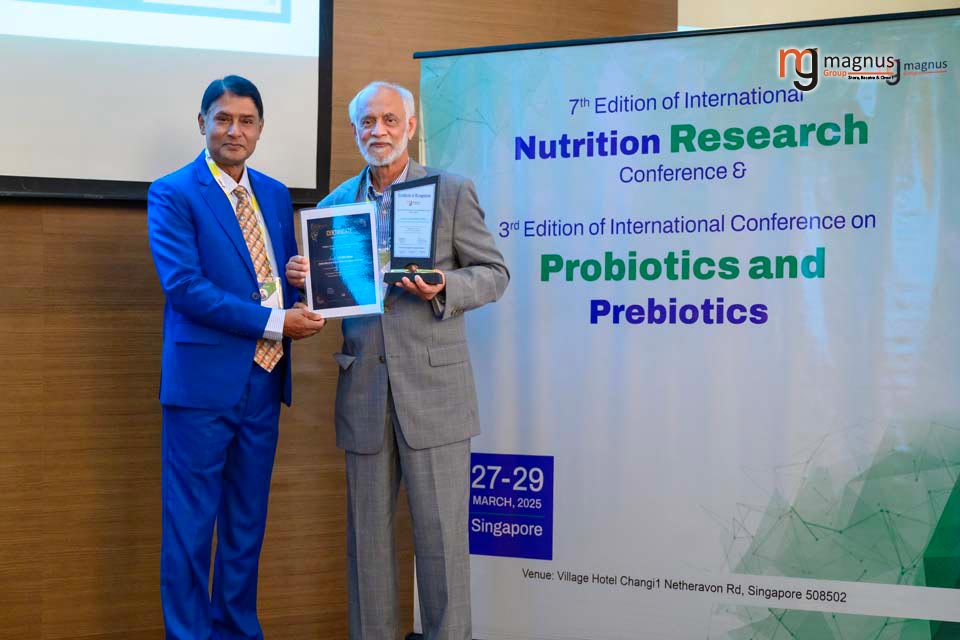Lincoln University Researcher Presents as Keynote Speaker at International Nutrition Conference in Singapore
Office of Communications and Marketing
Young Hall
820 Chestnut Street
Jefferson City, MO 65101
 Dr. Safiullah Pathan stands among quinoa plants inside one of Lincoln University’s advanced research facilities, where he studies their nutritional value and growth potential.
Dr. Safiullah Pathan stands among quinoa plants inside one of Lincoln University’s advanced research facilities, where he studies their nutritional value and growth potential.
Dr. Safiullah Pathan, associate professor of crop science and researcher at Lincoln University of Missouri (LU), recently served as a keynote speaker at the 7th International Nutrition Research Conference in Singapore, held March 27–29. The invitation marked a milestone for Lincoln University’s growing international presence in agricultural and nutritional science.
His presentation, titled “Quinoa Green Leaves: A Promising Nutrient-Rich Vegetable to Improve Human Health,” highlighted years of research conducted at Lincoln University on the nutritional benefits of quinoa’s leafy greens — an often-overlooked part of the plant. While quinoa grain is already celebrated as a superfood, Pathan’s presentation introduced international audiences to the nutritional potential of the plant’s greens. 
Dr. Safiullah Pathan, right, accepts a certificate of recognition after delivering a keynote presentation at the 7th International Nutrition Research Conference.
“Many people know about quinoa grains, but almost no one talks about the greens,” Pathan said. “We’ve published several peer-reviewed papers to show their health benefits, and we’re working to make this information more widely known — both in the U.S. and internationally.”
Quinoa greens — referring to the plant’s edible leaves, sprouts and microgreens — offer a rich source of nutrients. Research conducted at Lincoln University has shown these greens are high in protein and contain essential amino acids, dietary fiber, vitamins and antioxidants. Preliminary studies also indicate quinoa greens have anti-inflammatory and anti-obesity properties, supporting their use as a functional food with the potential to improve overall health and prevent chronic diseases.
Compared to other leafy greens, such as spinach or amaranth, quinoa greens are lower in carbohydrates while still delivering high levels of fiber and micronutrients. They also contain higher levels of omega-3 fatty acids than many similar leafy vegetables. Quinoa leaves have been linked to a wide range of health-promoting properties, including antimicrobial, anticancer, antidiabetic and anti-obesity effects, and are considered an excellent source of bioactive compounds.

Grato Ndunguru, a research technician with Lincoln University Cooperative Research, talks with a participant about quinoa at last year’s Quinoa Field Day at Carver Farm.
The greens can be enjoyed in a variety of ways — stir-fried, sautéed, stewed, steamed, blended into smoothies or served fresh in salads.
In addition to their nutritional value, quinoa greens offer practical benefits for growers. The plant is naturally drought-tolerant and requires minimal water to thrive, making it well-suited for changing climate conditions. Quinoa greens can be harvested in as little as 30 days, offering a fast-growing crop option for small-scale producers. As a leafy vegetable, quinoa greens provide an additional yield from the same crop, making them a valuable resource for both nutrition and sustainability.
Lincoln University is among the few institutions in the United States leading research on quinoa greens. Internationally, studies have been limited. Pathan emphasized that publishing this work in the U.S. lends it greater visibility and credibility in the global scientific community.
His keynote sparked strong interest and earned him an invitation to return as a 2026 keynote speaker and serve on the conference’s organizing committee.

A close-up of quinoa leaves grown at Lincoln University highlights their rich green color and edible texture.
Pathan’s research supports Lincoln’s broader mission of advancing food security and agricultural sustainability. In addition to its applications in human diets, quinoa is being explored as a multi-use crop — with potential uses in animal forage, microgreens and even honey production from its flowers. This versatility makes it especially valuable for small-scale producers seeking resilient and nutritionally dense crops.
As interest in alternative and climate-resilient crops grows, Pathan’s work positions LU at the forefront of this movement. His research continues to open new doors for collaboration, visibility and innovation — both nationally and abroad.
Lincoln University will host its annual Quinoa Field Day on July 15 at Carver Farm in Jefferson City, Missouri, where attendees can learn more about quinoa production, research developments and its potential as a high-value, sustainable crop.
For more information about quinoa, ongoing research or the upcoming field day, contact Dr. Safiullah Pathan at [email protected].
